Judging
from what we’ve been told in history books, when the Wright Brothers
invented powered flight, they were rewarded with parades, medals, and
headlines. But that’s a lie. The truth is, the U.S. government insisted
that one of the greatest technological achievements of all time simply
hadn’t happened. Here’s the true story.
CHANCE- THE UNINVITED GUEST
On
December 8, 1903, Samuel Langley, head of the Smithsonian Institution
and America’s foremost expert on flight, was ready to make his most
important attempt at manned flight. Since 1891 he’d been flying unmanned
models powered by internal combustion engines; the U.S. government
considered his experiments so promising that they’ve given him $50,000
to continue. Now he planned to fly his gasoline-powered, manned flight
off of a houseboat in the Potomac River. The press was on hand, waiting
expectantly.
But it didn’t happen. Unfortunately, the launching
device, which was supposed to hurl the plane into the air, snagged the
plane at the last second instead… and it went into the water “like a
handful of mortar.”
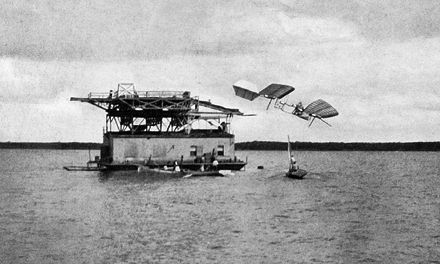
The
New York Times,
scornful of attempts at powered flight anyway, heaped abuse on Langley.
They editorialized: “The ridiculous fiasco… was not unexpected. The
flying machine might be evolved by the combined and continuous efforts
of mathematicians and mechanics in from one to ten million years.”
THE REAL THING
It
didn’t take that long. Only nine days later, on December 17, two
bicycle makers from Dayton, Ohio -Wilbur and Orville Wright- achieved
the goal of all the world’s would-be aviators: powered flight. It was a
revolutionary development in the history of humankind …but few people
even noticed. Only a few papers carried the Associated Press story of
the flight. Most editors considered the whole thing a scam. When the
Wrights set up the world’s first airstrip outside Dayton in 1904 and
flew daily all summer, only a few reporters came to see.
In fact, the first published eyewitness account of flight appears, amazingly enough, in a beekeeping journal called
Gleanings in Bee Culture.
And this almost a year after they started flying. The editor, A.I.
Root, saw the Wrights make aviation’s first turn on September 20, 1904
and wrote:
I have a
wonderful story to tell you, a story that in some respects outrivals
the Arabian Nights fables… It was my privilege, on the 20th day of
September, 1904 to see the first successful trip of an airship, without a
balloon to sustain it, that the world has ever made… These two brothers
have probably not even a faint glimpse of what their discovery is going
to bring to the children of men.
The scientific press was also slow to acknowledge the Wrights’ accomplishment. As Sherwood Hayes writes in
The First To Fly:
Scientific
American had been skeptical of reports about the Wright Brothers long
flights, its editorial board feeling that if the reports were true, then
certainly the enterprising American press would have given them great
attention. When the reports persisted, the magazine finally obtained
confirmation by letter from many reputable people who had witnessed the
actual flights. In its December 15 [1906] issue, the magazine stated its
complete acceptance of the Wrights.
MILITARY INTELLIGENCE
You’d
think the U.S. government would leap to purchase one of the most
revolutionary weapons ever. Not so. In 1904 after making flights of five
minutes, the Wrights wrote their Congressman, Robert Nevin, offering to
license their device to the government for military purposes. Their
letter said they’d made 105 flights up to 3 miles long at 35 mph. The
flying machine, they said, “lands without being wrecked” and “can be are
of great practical use in scouting and carrying messages in time of
war.” Interestingly enough, for many years the
only use the Wrights could imagine for their creation was war.)
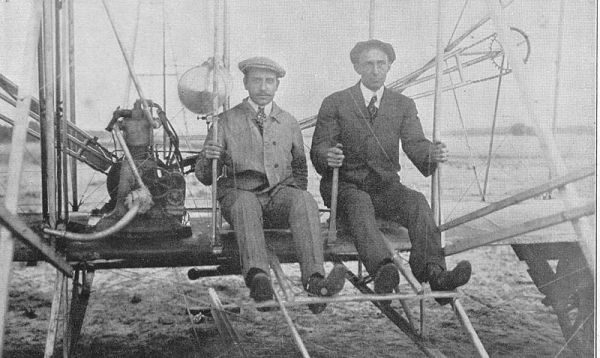
The
War Department, under future president William Howard Taft, responded
that they weren’t interested. They’d gotten many requests for “financial
assistance in the development of designs for flying machines” and would
only consider a device that had been “brought to the stage of practical
operation without expense to the U.S. government.” But, they added, do
get in touch “as soon as it shall have been perfected.”
In
October 1905, the Wrights wrote that they’d built a better plane and
made flights up to 39 minutes and over 20 miles. The War Department
again declined in a letter with almost the same wording -a form letter!
Obviously, either no one was reading their letters, or no one understood
what they were saying.
Showing incredible patience, the
frustrated Wrights politely wrote back again. This time they said they’d
build a flying machine to
any specifications the government
would name. The War Department, still clinging to the obvious
impossibility of powered flight, wrote back saying it “does not care to
formulate any requirements for the performance of a flying machine
…until a machine is produced with by actual operation is shown to be
able to produce horizontal flight and to carry an operator” -even though
they had already produced it. They were so dejected that they didn’t
fly again for two and half years.
ACCEPTED AT LAST
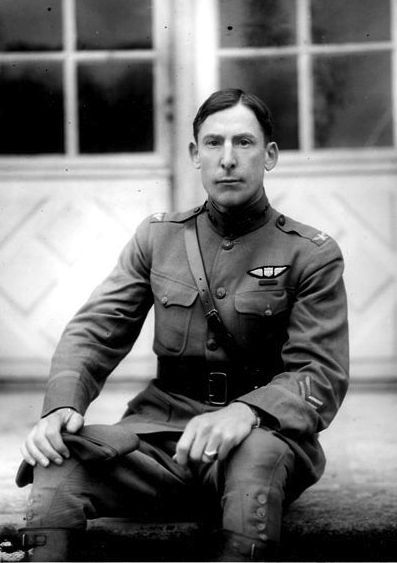
In
1907 a young balloon racer named Frank Lahm got a job with the Army
Signal Corps office in Washington, DC. He knew all the early flight
pioneers and had heard from them about the miracle achieved by the
Wrights. That, finally, was the Wrights’ big break. Fred Howard writes
in
Wilbur and Orville:
Lahn wrote a letter to
the Board of Ordnance and Fortification (of the Army Signal Corps),
urging that the brothers’ latest proposal for the sale of a Flyer
receive favorable action. It would be unfortunate, he said, if the U.S.
should not be the first to take advantage of [the] unquestioned military
value of the Wright Flyer. Lahm’s letter had the desired effect…
Wilbur
decided a fair price for the Flyer would be $25,000. The Board only had
$10,000… When Wilbur went to Washington to attend a formal meeting of
the Board, his frankness of manner and self-confidence worked their
usual magic and the Board assured him the entire $25,000 would be
forthcoming by drawing on an emergency fund left over from the
Spanish-American War.
MORE BUREAUCRATIC INSANITY
Apparently
nothing much has changed: Even though the Wrights were the only ones in
the world making practical airplanes, the U.S. government still had to
put a letter out for bids. So on December 23, 1907, it issued an
“Advertisement and specifications for a Heavier-Than-Air Flying
Machine,” capable of carrying two men at 40 mph and staying up for at
least an hour, then landing without serious damage. Critics howled. The
American Magazine of Aquatics
wrote, “There is not a known flying machine in the world which could
fulfill those specifications.” Amazingly, the Signal Corps got 41 bids,
with price tags ranging from $850 to $1 million. One was from a federal
prisoner who would build a plane for his freedom. Another had plans
written on wrapping paper and a third bidder offered to build planes by
the pound.
The Wrights, of course, got the contract.
I SEE LONDON, I SEE FRANCE
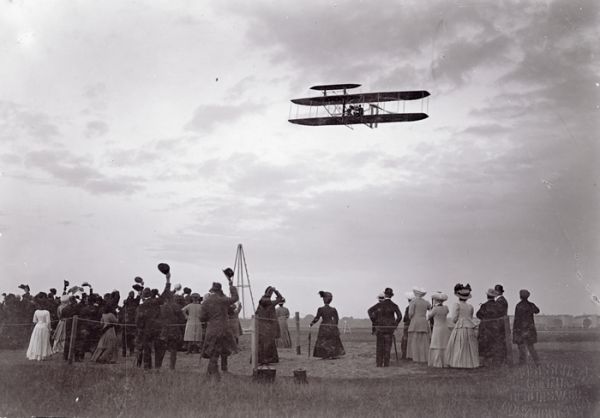
Still,
it was the French and British who first acknowledged the Wright
Brothers’ feats publicly. Shortly after winning the government contract
(but before they’d proved themselves by building the U.S. a plane),
Wilbur went to France to demonstrate their machine. The French were avid
aviators, and welcomed him enthusiastically… at first. Then, as he
rebuilt his plane (it had been damaged in shipping), working long hours
and living simply in a nearby room, they became suspicious. Why wasn’t
he more flamboyant?
Why didn’t he attend the rounds of parties, like
other celebrated French air pioneers?
Eventually,
the French and British press decided he was a charlatan. But on August
8, 1907, they changed their minds. “To make a long story short,”
recalled an American named Ross Browne, who was there to see Wilbur’s
first European flight, “he got into the machine that afternoon, got into
the air and made a beautiful circular flight. You should have seen the
crowd there. They threw hats and everything.”
STILL DUMB
Finally,
four years after the first flight, the Wright Brothers were heroes. But
there was one final insult: The Smithsonian Institution insisted that
the first manned flight had been Langley’s slam dunk into the Potomac.
They didn’t want the Wright Flyer, so it sat in a shed in Dayton until
1928… when Orville finally gave it to the London Museum of Science. Only
in 1942 did the Smithsonian bow to common knowledge, reverse its
position, and humbly asked for the plane. The Smithsonian restored it
and dedicated it in 1948, on the 45th anniversary of flight.
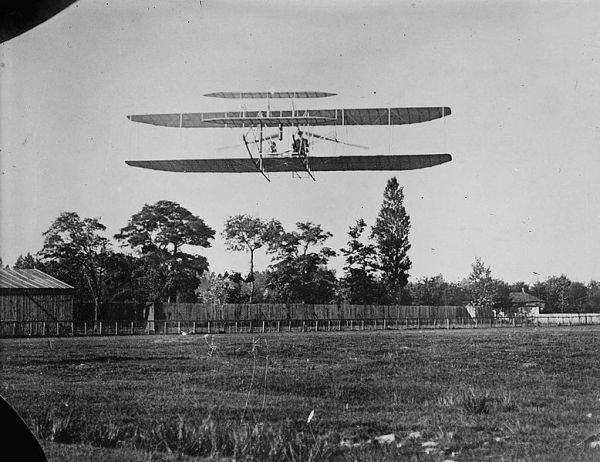


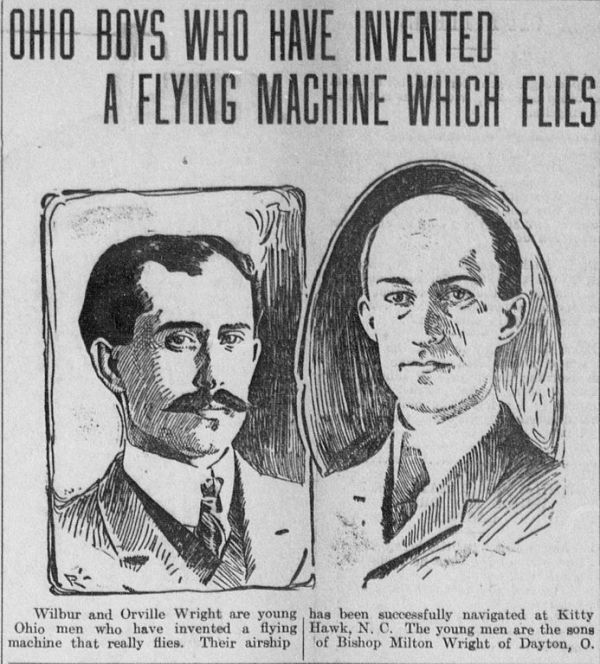

 In
1907 a young balloon racer named Frank Lahm got a job with the Army
Signal Corps office in Washington, DC. He knew all the early flight
pioneers and had heard from them about the miracle achieved by the
Wrights. That, finally, was the Wrights’ big break. Fred Howard writes
in Wilbur and Orville:
In
1907 a young balloon racer named Frank Lahm got a job with the Army
Signal Corps office in Washington, DC. He knew all the early flight
pioneers and had heard from them about the miracle achieved by the
Wrights. That, finally, was the Wrights’ big break. Fred Howard writes
in Wilbur and Orville:
No comments:
Post a Comment